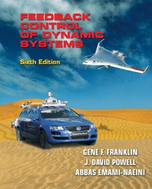Consider the 270-ft U.S. Coast Guard cutter Tampa (902) shown in Fig. 5.67. Parameter
Chapter 5, Problem 5.38(choose chapter or problem)
Consider the 270-ft U.S. Coast Guard cutter Tampa (902) shown in Fig. 5.67. Parameter identification based on sea-trials data (Trankle, 1987) was used to estimate the hydro-dynamic coefficients in the equations of motion. The result is that the response of the heading angle of the ship to rudder angle and wind changes w can be described by the second-order transfer functions where = heading angle, rad, r = reference heading angle, rad, r = yaw rate, rad/sec, = rudder angle, rad, w = wind speed, m/sec. (a) Determine the open-loop settling time of r for a step change in . (b) In order to regulate the heading angle , design a compensator that uses and the measurement provided by a yaw-rate gyroscope (that is, by = r). The settling time of to a step change in r is specified to be less than 50 sec, and for a 5 change in heading, the maximum allowable rudder angle deflection is specified to be less than 10. (c) Check the response of the closed-loop system you designed in part (b) to a wind gust disturbance of 10 m/sec. (Model the disturbance as a step input.) If the steady-state value of the heading due to this wind gust is more than 0.5, modify your design so that it meets this specification as well. Figure 5.67 USCG cutter Tampa (902) for 5.38
Unfortunately, we don't have that question answered yet. But you can get it answered in just 5 hours by Logging in or Becoming a subscriber.
Becoming a subscriber
Or look for another answer
